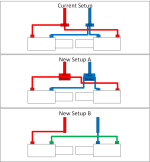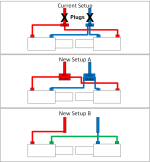oldnslo
Super Member
The problem I have is that when I'm driving the sled, if I'm on smooth hard ground the steering works great. If I am on a soft track, or if a tire hits a dirt clod or something when I'm backing up it will kick the tires out of line. It pushes the fluid right out of the cylinder and the tires will flop around and this is with me holding the steering wheel still. I know this setup works, almost every other sled out there uses one just like this. The only thing I'm not sure of is if they are using a different steering valve? I can't understand why the pressure could be just pushed out of the cylinder like that.
Can anyone give me ideas what may be wrong?
Justin
Justin,
Are their any valves between the gear type flow divider and the steering cylinders?
Are their any valves between the steering unit and the gear type flow divider?
How are the steering cylinders plumbed? Both rod ends together and both cap ends together or one rod end and one cap end?
Which end of the cylinders is connected to the gear type flow divider?
From what you describing their is a flow path created by pressure that allows the steering cylinders to move when the mechanical advantage builds pressure in the steering cylinders. Some gear type flow dividers have relief valves in each leg to prevent over pressurization in one of the circuits. You may need to install pressure gauges at the steering cylinders to determine at what pressure the cylinders start to move and then trace back to where the leak point is. I believe some steering units also have work port reliefs built into them but not 100 sure on this.
A possible test:
With the engine off can you remove the tank line hose from the steering unit and then apply a mechanical load to the steering cylinder like you are driving and hit a rock. If fluid comes out the tank line when the steering cylinders move the problem would then appear to be in your steering unit.
Last edited:



